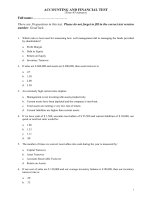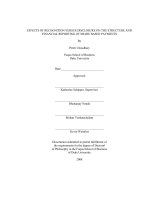Accounting and financial reporting
Bạn đang xem bản rút gọn của tài liệu. Xem và tải ngay bản đầy đủ của tài liệu tại đây (652.31 KB, 44 trang )
Accounting and
Financial
Reporting
Back to Table of Contents
Chapter 20
Accounting and Financial Reporting
Accounting and
Financial Reporting
20.1
Financial Record Keeping
20.2
Preparing Financial Statements
2
Accounting and Financial Reporting
20.1
Explain the important role accounting plays in
business.
Explain the accounting systems for a small
business.
Describe the importance of daily sales and
cash receipts reports.
Section 20.1 Financial Record Keeping
3
Accounting and Financial Reporting
20.1
All businesses must record and report all
financial activities using established concepts
and procedures.
Section 20.1 Financial Record Keeping
4
Accounting and Financial Reporting
20.1
financial reports
accounting period
calendar year
fiscal year
assets
current assets
accounts receivable
fixed assets
liabilities
accounts payable
Section 20.1 Financial Record Keeping
owner’s equity
chart of accounts
debits
credits
cash basis
accrual basis
journal
journalizing
general journal
posting
5
Accounting and Financial Reporting
Accounting for Business
One of the most important operations in the day-today activities of your business is maintaining
accurate up-to-date financial records.
Accounting records and reports help you run your
business efficiently and profitably by keeping track
of money earned and spent.
Section 20.1 Financial Record Keeping
6
Accounting and Financial Reporting
Accounting for Business
All U.S. businesses, large
and small, use the GAAP
system for their financial
records.
Section 20.1 Financial Record Keeping
GAAP generally
accepted accounting
principles established to
allow all businesses to
use the same system of
recording and reporting
financial information
7
Accounting and Financial Reporting
Accounting for Business
Financial reports indicate
to banks, buyers,
government agencies, and
consumers how well your
business is doing.
Section 20.1 Financial Record Keeping
financial reports
statements or
documents that
summarize the results of
a business operation
and provide a picture of
its financial position
8
Accounting and Financial Reporting
Accounting Assumptions
When creating the accounting books for your
business, you will make two assumptions:
1. Your business will operate as a separate entity.
2. Your financial reports will always cover a
specific time period.
Section 20.1 Financial Record Keeping
9
Accounting and Financial Reporting
Accounting Assumptions
Financial reports must
always cover an
accounting period.
Section 20.1 Financial Record Keeping
accounting period a
block of time, such as a
month, a quarter, or a
year, covered by an
accounting report
10
Accounting and Financial Reporting
Accounting Assumptions
You may choose either a
calendar year or a fiscal
year for your business’s
accounting period.
Section 20.1 Financial Record Keeping
calendar year the
accounting period of
time from January 1 to
December 31
fiscal year the
accounting period of
time that begins and
ends in months other
than the calendar year
11
Accounting and Financial Reporting
The Accounting Equation
The accounting equation,
the basis for keeping
financial records, is as
follows:
assets anything of
value that a business
owns, such as cash,
equipment, or a building
assets = liabilities + owner’s equity
Section 20.1 Financial Record Keeping
12
Accounting and Financial Reporting
The Accounting Equation
Assets are further broken
down to include current
assets, such as accounts
receivable, and fixed
assets.
current assets cash or
any other items that can
be converted to cash
quickly and used by a
business within a year
accounts receivable
the amount customers
owe a business
fixed assets any items
that will be held by a
business for more than one
year, such as equipment,
trucks, or buildings
Section 20.1 Financial Record Keeping
13
Accounting and Financial Reporting
The Accounting Equation
Total assets minus total
liabilities, which includes
accounts payable, equals
the owner’s equity.
liabilities the debts of
a business
accounts payable the
amount a business owes
to creditors
owner’s equity the worth
of a business
Section 20.1 Financial Record Keeping
14
Accounting and Financial Reporting
The Accounting System
Each business must create its own set of accounts.
Each business will have different accounts, but all
will use the same concepts and procedures for
recording, summarizing, and report the financial
information.
Section 20.1 Financial Record Keeping
15
Accounting and Financial Reporting
Creating Accounts
When you create the books
of your business, you create
a chart of accounts for
each of the three categories
in the accounting equation:
assets, liabilities, and
owner’s equity.
Section 20.1 Financial Record Keeping
chart of accounts the
list of accounts a
business uses in its
operation
16
Accounting and Financial Reporting
Double-Entry Accounting
Most businesses use a
double-entry accounting
system in which each
business transaction affects
two or more accounts.
debits additions to the left
side of an account that
increase the balance of all
assets and expense
accounts and decrease the
balance of all liability and
revenue accounts
These changes are
identified by entering debits
or credits.
credits additions to the
right side of an account
that decrease the balance
for all assets and expense
accounts and increase the
balance for all liability and
revenue accounts
Section 20.1 Financial Record Keeping
17
Accounting and Financial Reporting
Cash or Accrual Basis
Income and payments are
recorded by using a cash
basis or accrual basis
system.
cash basis an
accounting system in
which income is recorded
when it is received, and
expenses are recorded
when they are paid
accrual basis an
accounting system in
which income is recorded
when it is earned, and
expenses are recorded
when they are paid
Section 20.1 Financial Record Keeping
18
Accounting and Financial Reporting
Journalizing Business
Transactions
It is important for a business
to keep a journal to record
business transactions as
they occur.
Journalizing helps a
business owner keep up-todate on his or her financial
transactions.
Section 20.1 Financial Record Keeping
journal a financial diary
of a business
journalizing the
process of recording
business transactions,
usually on a daily basis
as they occur
19
Accounting and Financial Reporting
Journalizing Business
Transactions
The general journal is the
type of journal most
commonly used by
businesses.
Section 20.1 Financial Record Keeping
general journal an allpurpose journal that is
used to record all types of
business transaction
20
Accounting and Financial Reporting
Posting to the General
Ledger
By posting to the general
ledger, you can find the
balance of each account.
Section 20.1 Financial Record Keeping
posting the process of
transferring amounts from
the general journal to
accounts in the general
ledger
21
Accounting and Financial Reporting
Using Sales and Cash
Receipts Report
Businesses that have regular daily sales should
prepare these daily reports:
Cash receipts
Cash on hand
Sales
Section 20.1 Financial Record Keeping
22
Accounting and Financial Reporting
20.1
1. Explain the important role accounting plays in
business.
Good financial management is essential to
sound business management. Accounting
provides the vital financial information owners
need to make sound business decisions.
Section 20.1 Financial Record Keeping
23
Accounting and Financial Reporting
20.1
2. Explain the accounting systems for a small
business.
A small business creates accounts, most likely
uses double-entry accounting, decides whether
to operate under a cash or accrual basis, records
business transactions in a journal, and posts to
the general ledger.
Section 20.1 Financial Record Keeping
24
Accounting and Financial Reporting
20.1
3. Describe the importance of daily sales and
cash receipts reports.
These reports allow a business owner to
examine total daily sales and to verify the total
cash received.
Section 20.1 Financial Record Keeping
25









